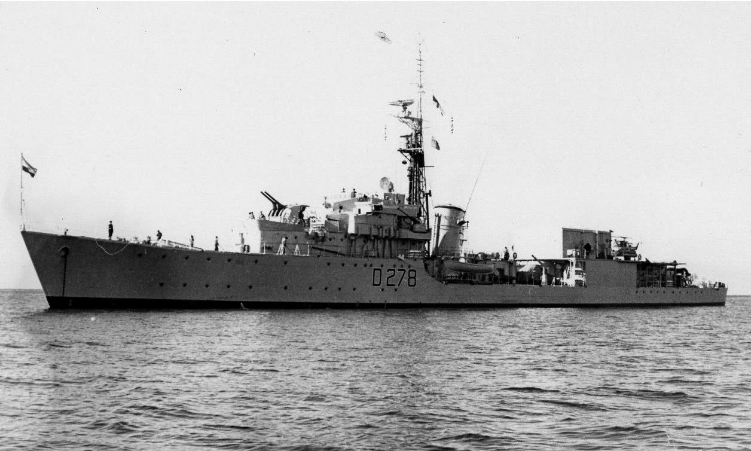
Wager class Destroyers (1950)
 South African Navy (1950-80)
South African Navy (1950-80)
SAS Jan Van Riebeeck (D278), SAS Simon Van Der Stel (D237)
Wager class joins South African Navy:

SAS Jan Van Riebeeck after conversion (C.Haycocks)
On 29 March 1950, South Africa received its first destroyer HMSAS Jan van Riebeeck (former HMS Wessex), at the HM Dockyard in Simons’s Town, with the British High Commissioner Sir Evelyn Baring officially handing the vessel over to the Union Government. Nearly three years later, the South African Navy would acquire her sister ship HMS Whelp, which was commissioned into the South African Navy on 23 February 1953 as SAS Simon van der Stel, with the letters HM being dropped from the names of SA naval vessels in June 1952.
Both ships were units of the Wager class of fleet destroyers, which formed the 9th flotilla of the Emergency War Construction Program, which was constructed between 1943 and 1944. These destroyers were cheaper editions to the earlier J, K and N class destroyers built. The Wager class destroyers were fitted with guns and mountings, which were readily available and was strongly built. They were excellent sea boats and could operate their weapons in almost any weather. Wager class destroyers gave exceptional service, and most of those who survived the war would end up joining post-war fleets, one example being the South
African Navy.
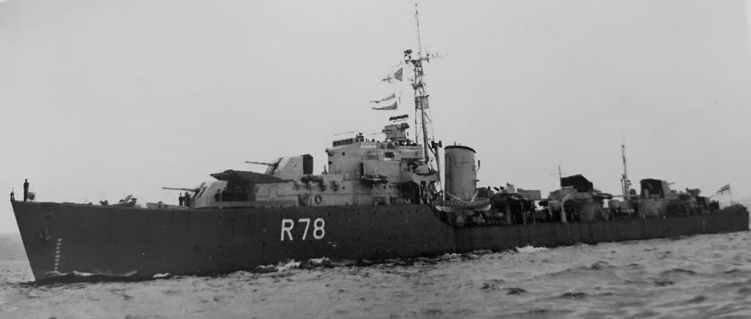
HMS Wessex, which was transferred to the South African Navy and renamed HMSAS Jan van Riebeeck on 29 March 1950 (Imperial War Museum)
Design
Armaments and Electronics
The main task of destroyers at the beginning of World War Two was to protect friendly vessels from enemy vessels, such as other destroyers and even submarines. To accomplish this, they needed heavy armament in the form of both torpedoes and guns. The Wager class were the last British destroyers to be fitted with 4,7-inch guns. They were fitted with four single 4,7-inch mountings, two forward and two aft. Working in conjunction with the guns the vessel was equipped with a combined dual-purpose HA/LA director with a Mk III range finder incorporated on the bridge.
Secondary armament includes two quadruple 21-inch torpedo launchers, one twin 40mm Mk IV Hazemeyer Bofors (one quadruple two-pounder pom-pom anti-aircraft mounting fitted in Wessex and whelp) and four twin 20mm Oerlikons. Anti-submarine armament includes two depth-charge throwers on either side of the deckhouse aft and two rails at the stern. The Wager class were also the first destroyers in its entire class to be fitted with a heavy lattice foremast with Type 276 radar.
Propulsion
The Wager class destroyers were powered by two Admiralty 3-drum boilers, which were positioned in separate boiler rooms, back-to-back, enabling the uptakes to be turned into a single funnel. The steam turbines developing 40 000 horsepower were arranged in two sets in a single engine room and drove two shafts through single reduction gears positioned in a separate gearing room abaft the engine room. These vessels could achieve a top speed of 36,75 knots and travel a total distance of 4 680 nautical miles at 20 knots.
⚙ Specifications: Wager class (As Built) |
|
| Displacement: | Standard 1 710 tons, Full Load 2 505 tons |
| Dimensions: | 110,60m x 10,87m x 3,51m |
| powerplant: | Two shafts Parsons SRGT turbines, two Admiralty 3D +Melesco superheaters, 40 000 hp |
| Speed and range: | 36,75 knots, 4 680 nautical miles at 20 knots |
| Armament: | -Four single 4,7-inch QFSA Mk9 low-angle guns -One quadruple 2-pdr pom-pom -Four twin 20mm Oerlikons Mk12 -Two quadruple 21-inch Mk7 -Four depth-charge throwers -Two depth-charge rails stern |
| Electronics: | See notes, Radar type 276 |
| Crew: | 179 |
Wager class at sea
Two years after commissioning, the SAS Jan van Riebeeck was most appropriately selected to represent the SA Navy at the Van Riebeeck festival held in Cape Town in April 1952 to commemorate the 300th anniversary of the arrival of Jan van Riebeeck at the Cape. After the festival, she underwent a refit in Simon’s Town before returning to Durban, the home port of the SA Navy in those days. During the latter half of 1952, she conducted a month-long cruise to East African ports, including stops at Diego Suarez, Mombasa and Dar es Salaam. In early 1953 she sailed from Durban to Simon’s Town, where she was laid up in reserve to provide a crew for the commissioning of SAS Simon van der Stel. This became the norm throughout their long service with the South African Navy.
In 1954, a little over a year after being handed over to South Africa, the SAS Simon van der Stel, under the command of M R Terry Lloyed, made a historic cruise to northern waters, which lasted nearly five months. SAS Simon van der Stel sailed from Durban on 14 July 1954, making her first stop in Cape Town to top up with fuel and supplies before heading to Walvis Bay. She proceeded to Freetown in Sierra Leone, followed by Dakar, before arriving in Portsmouth on 31 July 1954. After spending two weeks alongside the British battleship HMS Vanguard in Portsmouth, SAS Simon van der Stel also paid a highly successful visit to Rotterdam, being the first and to date only South African war vessel to visit the Netherlands.
After the visit to the Netherlands, SAS Simon van der Stel returned to Portsmouth and then proceeded to Londonderry in Northern Ireland before going up the Clyde to Glasgow, which was later to become home to many South Africans involved in the construction of three Type 12 frigates built there during the early 1960s. On the return voyage to South Africa, SAS Simon van der Stel escorted the newly acquired Ford class Seaward Defence Boat SAS Gelderland. The two vessels left Portsmouth on 21 October 1954 and after encountering bad weather with waves continually breaking over the bridge of the much smaller SAS Gelderland, the decision was made to visit the French naval port of Brest to wait out the bad weather before continuing.
SAS Simon van der Stel and SAS Gelderland continued on their journey, making stops at Lisbon, Las Palmas, Dakar, Abidjan, Pointe Noire, Walvis Bay, Cape Town and Port Elizabeth before finally arriving at Durban on 8 December 1954. SAS Simon van der Stel has covered a distance of 17 200 nautical miles and has been away from her home port for a total of 147 days. After four years in commission, SAS Simon van der Stel was decommissioned on 18 February 1957 and joined her sister ship in reserve.
Modernisation program
Whilst both ships were laid up, the striking power of the SA navy came under intense review. By this time, the rapid advances in submarine designs and technology meant the two destroyers were not as capable anymore of countering enemy submarines. The use of shipborne helicopters with anti-submarine capabilities would appear to be the answer; thus plans were drawn up to convert both ships into fast, helicopter-carrying anti-submarine escorts. The first ship to be taken in for modernisation was SAS Simon van der Stel, which was taken in hand by the SA Naval dockyard in Simon’s Town in 1962. SAS Simon van der Stel was recommissioned on 27 February 1964 when work started on the modernisation of SAS Jan van Riebeeck.
The conversion, which gave the ships unique silhouettes, included fitting a flight deck and a hanger for two Westland Wasp HAS Mk 1 helicopters for standoff weapons delivery. The main armament, four single 4,7-inch guns were replaced by 4-inch guns in twin Mk 19 mountings, one forward and one aft. SAS Simon van der Stel initially shipped a modified gun-director system, but this was later replaced by an Elsag NA9 fire control system, similar to that fitted in SAS Jan van Riebeeck during her refit. The operations room of each ship was also enlarged, and a great deal of new electronic equipment was fitted, along with new communications systems, with the Type 293 search radar and masthead being retained.
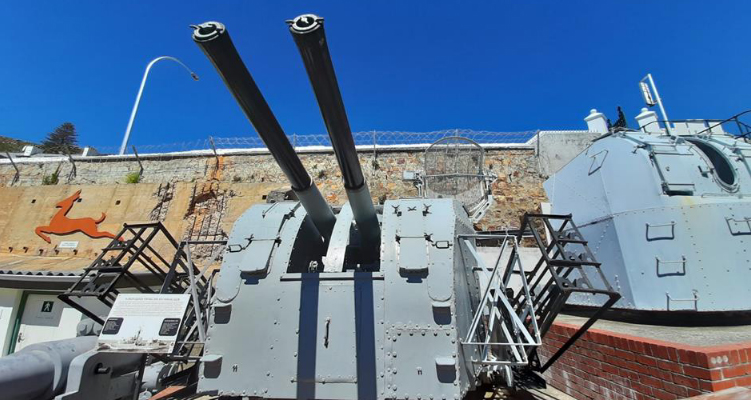
4-inch guns in twin Mk 19 mountings at the SA Naval Museum (R.Ackerman)
On SAS Simon van der Stel all the secondary armament was removed and replaced by four single 40/60 Bofors, two fitted on each side of the bridge structure and two on the flight deck. Both depth charge rails were retained, as well as two of the four depth charge throwers. One of the two quadruple 21-inch torpedo launchers was removed in order to make space for the flight deck, the remaining torpedo launcher would be removed at a later stage.
During the SAS Jan van Riebeeck modernisation program the ship was fitted with the two single 40/60 Bofors on the bridge and two triple Mk 32 anti-submarine torpedo tubes on the flight deck in place of the two single 40/60 Bofors and would also retain the depth charge rails and throwers. At a later stage, SAS Simon van der Stel would receive the same modification as SAS Jan van Riebeeck with the removal of the two single 40/60 Bofors on the flight deck and the addition of two triple Mk 32 anti-submarine torpedo tubes, making both ships nearly identical.
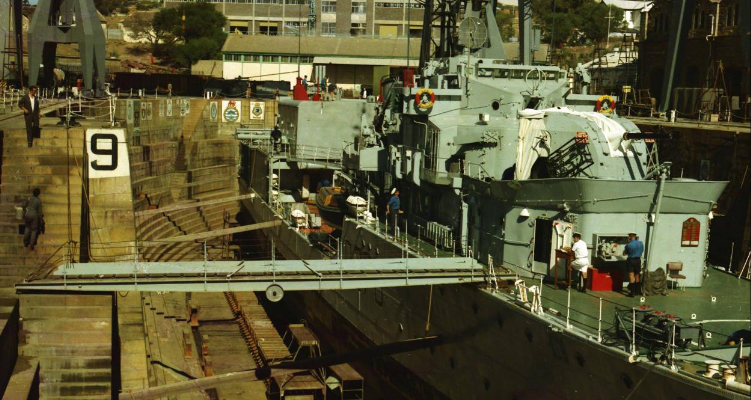
SAS Jan van Riebeeck at the SA Naval dockyard in Simon’s Town (D. Harrison)
⚙ Specifications: Wager class (As Frigates) |
|
| Displacement: | Standard 2,105 tons, Full Load 2,750 tons |
| Speed and range: | 31,25 knots, same |
| Armament: | -Two twin 4-inch guns in Mk19 dual-purpose mountings -Two single 40/60 Bofors Mk9 -Two triple-barrelled Mk32 launchers -Two depth charge throwers, Two depth charge rails |
| Onboard Aviation: | Two Westland Wasp HAS Mk1 helicopters armed with: Mk44 anti-submarine torpedoes or Mk11 depth charges |
| Electronics: | See notes, Radar type 293 |
| Crew: | 186-210 |
Wager class in reserve
Once the modernisation was completed for the SAS Simon van der Stel, the vessel remained in commission for just over a year before being placed in reserve in March 1965. This was due to a manpower shortage, brought about by the commissioning of three new Type 12 frigates (President class frigates) by the South African Navy. The SAS Jan van Riebeeck would also end up in the same position as her sister ship, after completing its trials in July 1966, being placed in reserve due to the manpower shortage, as a result of the new frigates being commissioned.
After spending three years in reserve, SAS Simon van der Stel was recommissioned on 17 June 1968 and joined the 10th Frigate Squadron, this however was short-lived and on 1 October 1968 SAS Simon van der Stel withdrew from frontline service and became an independent unit employed as a training vessel. Later in October 1968, SAS Simon van der Stel would visit Lourenco Marques in company with the SAS Kimberly and the SAS
Mosselbaai, where they took part in ceremonies, leading up to the unveiling of a Garden of Remembrance to the Voortrekker leader Louis Trichardt.
After numerous flag-showings and training cruises, SAS Simon van der Stel was finally decommissioned at sunset on 27 March 1972, with her role as a training vessel being taken over by her sister ship SAS Jan van Riebeeck, which has gone through an extensive electronic and general refit in March 1971 and being recommissioned for limited service on 12 April 1972. With South African Navy flag showings not taking place as often anymore the SAS Jan van Riebeeck would once again be placed in reserve in late 1975 after only a few years of serving as a training vessel.
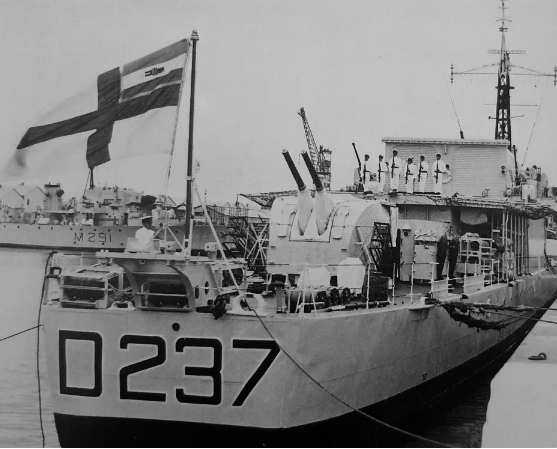
SAS Simon van der Stel’s stern, anchored (Cape Times)
The end of the Wager class
By the time SAS Jan van Riebeeck was placed into reserve in 1975, the SAS Simon van der Stel had temporalty been reactived after its decommissioning. With only a skeleton crew, the vessel was escorted to Durban by the SAS President Kruger in early 1975, where it was planned to refit the vessel at the newly reopened Salisbury Island Naval Base. However, it was subsequently found that the general state of the ship was such that it would not be economically viable to refit the vessel.
In late 1976, SAS Simon van der Stel was stripped of all her useful gear before finally being scrapped by Sandock Austral at their Bay-Head yard. Despite her lowly end, her hanger structure eventually became a temporary paint shop at the yard, a sad reminder of a once proud ship. A few years later the SAS Jan van Riebeeck would also meet its end and be stripped of all her useful equipment. On March 1980 she was used as a missile target some sixty nautical miles south of Cape Point. Here she was sent to the bottom of the ocean in an exercise to prove the effectiveness of the weapon system fitted to the SA Navy’s new Minster class Strike craft.
The thirty-six-year-old vessel was torn apart by a single Skerpioen (Scorpion) surface-to-surface missile fired by the strike craft SAS Jim Fouche from over the horizon, which struck the vessel amidship leaving a huge hole. As a result of her light condition and the calm seas prevailing, it was necessary for additional participating units to engage her before she sunk. Her final moments above the waves obscured by dense smoke.
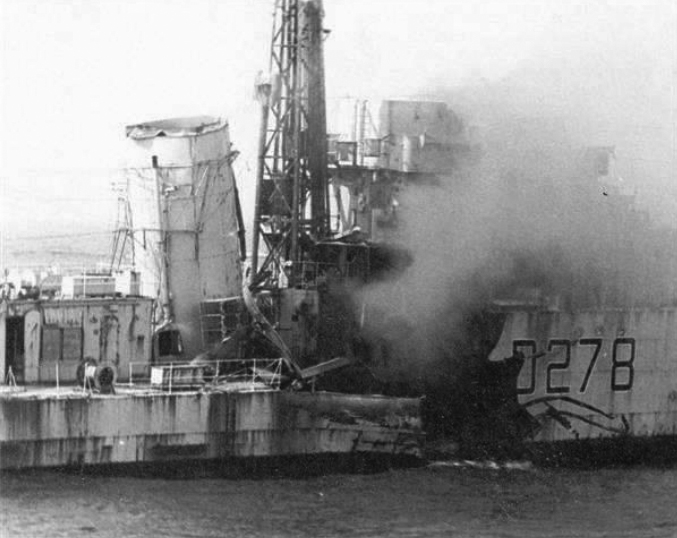
SAS Jan van Riebeeck after being hit by a Skerpioen missile 1980 (D. Collopy)
20/08/2022 By Reinhardt Ackerman
Read More/Src
Toit, A. D. 1992. South Africa’s Fighting Ships Past and Present . Ashanti Publishings (Pty) Ltd, pp. 193-200.
Wessels, A. 2022.A centuary of South African naval history.Naledi, pp. 95-99, 147-151.


 Latest Facebook Entry -
Latest Facebook Entry -  X(Tweeter) Naval Encyclopedia's deck archive
X(Tweeter) Naval Encyclopedia's deck archive Instagram (@navalencyc)
Instagram (@navalencyc)





 French Navy
French Navy Royal Navy
Royal Navy Russian Navy
Russian Navy Armada Espanola
Armada Espanola Austrian Navy
Austrian Navy K.u.K. Kriegsmarine
K.u.K. Kriegsmarine Dansk Marine
Dansk Marine Nautiko Hellenon
Nautiko Hellenon Koninklije Marine 1870
Koninklije Marine 1870 Marinha do Brasil
Marinha do Brasil Osmanlı Donanması
Osmanlı Donanması Marina Do Peru
Marina Do Peru Marinha do Portugal
Marinha do Portugal Regia Marina 1870
Regia Marina 1870 Nihhon Kaigun 1870
Nihhon Kaigun 1870 Preußische Marine 1870
Preußische Marine 1870 Russkiy Flot 1870
Russkiy Flot 1870 Svenska marinen
Svenska marinen Søværnet
Søværnet Union Navy
Union Navy Confederate Navy
Confederate Navy Armada de Argentina
Armada de Argentina Imperial Chinese Navy
Imperial Chinese Navy Marinha do Portugal
Marinha do Portugal Mexico
Mexico Kaiserliche Marine
Kaiserliche Marine 1898 US Navy
1898 US Navy Sovietskiy Flot
Sovietskiy Flot Royal Canadian Navy
Royal Canadian Navy Royal Australian Navy
Royal Australian Navy RNZN Fleet
RNZN Fleet Chinese Navy 1937
Chinese Navy 1937 Kriegsmarine
Kriegsmarine Chilean Navy
Chilean Navy Danish Navy
Danish Navy Finnish Navy
Finnish Navy Hellenic Navy
Hellenic Navy Polish Navy
Polish Navy Romanian Navy
Romanian Navy Turkish Navy
Turkish Navy Royal Yugoslav Navy
Royal Yugoslav Navy Royal Thai Navy
Royal Thai Navy Minor Navies
Minor Navies Albania
Albania Austria
Austria Belgium
Belgium Columbia
Columbia Costa Rica
Costa Rica Cuba
Cuba Czechoslovakia
Czechoslovakia Dominican Republic
Dominican Republic Haiti
Haiti Hungary
Hungary Honduras
Honduras Estonia
Estonia Iceland
Iceland Eire
Eire Equador
Equador Iran
Iran Iraq
Iraq Latvia
Latvia Liberia
Liberia Lithuania
Lithuania Mandchukuo
Mandchukuo Morocco
Morocco Nicaragua
Nicaragua Persia
Persia San Salvador
San Salvador Sarawak
Sarawak Uruguay
Uruguay Venezuela
Venezuela Zanzibar
Zanzibar Warsaw Pact Navies
Warsaw Pact Navies Bulgaria
Bulgaria Hungary
Hungary

 Bundesmarine
Bundesmarine Dutch Navy
Dutch Navy Hellenic Navy
Hellenic Navy Marina Militare
Marina Militare Yugoslav Navy
Yugoslav Navy Chinese Navy
Chinese Navy Indian Navy
Indian Navy Indonesian Navy
Indonesian Navy JMSDF
JMSDF North Korean Navy
North Korean Navy Pakistani Navy
Pakistani Navy Philippines Navy
Philippines Navy ROKN
ROKN Rep. of Singapore Navy
Rep. of Singapore Navy Taiwanese Navy
Taiwanese Navy IDF Navy
IDF Navy Saudi Navy
Saudi Navy Royal New Zealand Navy
Royal New Zealand Navy Egyptian Navy
Egyptian Navy South African Navy
South African Navy






























 Ukrainian Navy
Ukrainian Navy dbodesign
dbodesign